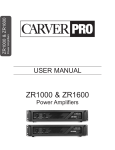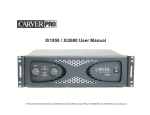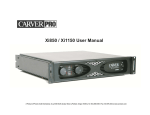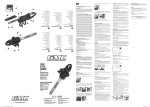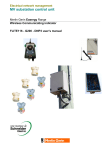Download Polaris 850 XP EPS Offroad Vehicle User Manual
Transcript
Introduction Safety Information CAUTION RISK OF ELECTRIC SHOCK DO NOT OPEN CAUTION: TO REDUCE THE RISK OF ELECTRIC SHOCK DO NOT REMOVE COVER (OR BACK) NO USER-SERVICEABLE PARTS INSIDE REFER SERVICING TO QUALIFIED SERVICE PERSONNEL The lightning flash with arrowhead symbol within an equilateral triangle is intended to alert the user to the presence of uninsulated"dangerous voltage" within the product's enclosure, that may be of sufficient magnitude to constitute a risk of electric shock to persons. The exclamation point within an equilateral triangle is intended to alert the user of the presence of important operating and maintenance (servicing) instructions in the literature accompanying the appliance. Table Of Contents Introduction ............................................................2 Unpacking and Paperwork.....................................2 Features and Specifications PX850..............................................................3-4 PX1450............................................................5-6 Controls and Features .........................................7-8 Installation and Operations Location and General Precautions .....................9 Mechanical Considerations ................................9 Rear Support.......................................................9 Thermal Considerations .....................................9 AC Power Considerations..................................9 Magnetic Leakage Considerations.....................9 Input Wiring .......................................................9 Installation (continued) Input Sensitivity ...............................................10 Output Wiring...................................................11 Polarity .............................................................11 Bridged Mono...................................................11 Parallel Mono ...................................................11 70V Distribution Systems...........................11-12 Signal Smart Standby Circuit...........................12 Operating Tips......................................................13 Care and Service Assistance ................................13 Configurable Gain Controls.................................14 In Case of Difficulty.............................................15 Warranty Information...........................................16 Accessories......................................................17-18 Congratulations on your purchase of a new Carver Professional Power Amplifier. The PX850 and PX1450 are designed for any pro audio application. The PX Series is the first line designed and produced by Carver Professional, a division of Phoenix Gold International, Inc. It combines the Pro Audio experience and sonic heritage of Carver Professional with the performance, manufacturing quality and attention to detail that has defined Phoenix Gold International. Thank you for placing your confidence in Carver Professional and Phoenix Gold. We know your amplifier will provide many years of dependable service and reliable sound reproduction. Please read all of this manual, especially the Safety Warnings, before operating your amplifier. Unpacking and Paperwork Carefully unpack the amplifier and keep the original carton and packing materials for future moving, shipment or long-term storage. After opening the box, please check for any visible signs of damage that were not apparent from the outside of the box. If you do encounter what appears to be concealed damage, please consult your Carver Professional Dealer before installing the unit. Important Paperwork Make sure to save your sales receipt. Your receipt is extremely important to establish the duration of your Limited Warranty and for insurance purposes. Next, make a note of the serial number which is located on the back of the amplifier. Record it in the space provided below for convenient reference. Model: _____PX850_____PX850BR _____PX850SP ____PX1450____PX1450 BR ____PX1450SP Serial Number: _____________________________ Purchased at: _______________________________ Date: _____________________________________ Finally, take a moment to fill out and return the Warranty Registration Card packed with the amplifier and return it to Carver Professional. This will allow us to keep you informed about new products as they become available. 2 Introduction Safety Information CAUTION RISK OF ELECTRIC SHOCK DO NOT OPEN CAUTION: TO REDUCE THE RISK OF ELECTRIC SHOCK DO NOT REMOVE COVER (OR BACK) NO USER-SERVICEABLE PARTS INSIDE REFER SERVICING TO QUALIFIED SERVICE PERSONNEL The lightning flash with arrowhead symbol within an equilateral triangle is intended to alert the user to the presence of uninsulated"dangerous voltage" within the product's enclosure, that may be of sufficient magnitude to constitute a risk of electric shock to persons. The exclamation point within an equilateral triangle is intended to alert the user of the presence of important operating and maintenance (servicing) instructions in the literature accompanying the appliance. Table Of Contents Introduction ............................................................2 Unpacking and Paperwork.....................................2 Features and Specifications PX850..............................................................3-4 PX1450............................................................5-6 Controls and Features .........................................7-8 Installation and Operations Location and General Precautions .....................9 Mechanical Considerations ................................9 Rear Support.......................................................9 Thermal Considerations .....................................9 AC Power Considerations..................................9 Magnetic Leakage Considerations.....................9 Input Wiring .......................................................9 Installation (continued) Input Sensitivity ...............................................10 Output Wiring...................................................11 Polarity .............................................................11 Bridged Mono...................................................11 Parallel Mono ...................................................11 70V Distribution Systems...........................11-12 Signal Smart Standby Circuit...........................12 Operating Tips......................................................13 Care and Service Assistance ................................13 Configurable Gain Controls.................................14 In Case of Difficulty.............................................15 Warranty Information...........................................16 Accessories......................................................17-18 Congratulations on your purchase of a new Carver Professional Power Amplifier. The PX850 and PX1450 are designed for any pro audio application. The PX Series is the first line designed and produced by Carver Professional, a division of Phoenix Gold International, Inc. It combines the Pro Audio experience and sonic heritage of Carver Professional with the performance, manufacturing quality and attention to detail that has defined Phoenix Gold International. Thank you for placing your confidence in Carver Professional and Phoenix Gold. We know your amplifier will provide many years of dependable service and reliable sound reproduction. Please read all of this manual, especially the Safety Warnings, before operating your amplifier. Unpacking and Paperwork Carefully unpack the amplifier and keep the original carton and packing materials for future moving, shipment or long-term storage. After opening the box, please check for any visible signs of damage that were not apparent from the outside of the box. If you do encounter what appears to be concealed damage, please consult your Carver Professional Dealer before installing the unit. Important Paperwork Make sure to save your sales receipt. Your receipt is extremely important to establish the duration of your Limited Warranty and for insurance purposes. Next, make a note of the serial number which is located on the back of the amplifier. Record it in the space provided below for convenient reference. Model: _____PX850_____PX850BR _____PX850SP ____PX1450____PX1450 BR ____PX1450SP Serial Number: _____________________________ Purchased at: _______________________________ Date: _____________________________________ Finally, take a moment to fill out and return the Warranty Registration Card packed with the amplifier and return it to Carver Professional. This will allow us to keep you informed about new products as they become available. 2 PX850 • 250W per channel into 8 ohms • • • • 425W per channel into 4 ohms 525W per channel into 2 ohms Three connector versions available: Standard Neutrik™ combi inputs with Binding Post outputs BR Version - Barrier Strip inputs and outputs SP Version - Neutrik™ combi inputs with Neutrik™ Speakons™ and Binding Post outputs Independent 41 detent Level Controls for CH1 & CH2 Externally configurable for Parallel Mono mode to operate both channels with a mono signal Externally configurable for Bridged Mono mode to combine the power of both channels into a higher powered mono channel • Externally configurable input sensitivity @ 0.775V, 1.5V or fixed +28dB gain • Protection circuitry includes DC Fault, Thermal, and Short Circuit Power Ready, Signal Present, Clip, Protect, • Thermal and Standby indicators for each channel • Variable Speed Fan • Front or Rear Gain Controls (field configurable) • Signal Smart Standby Circuitry. Power saving • feature which automatically turns off or on the amplifier based on the presence of a signal and the position of the threshold adjustment RAMP optional computer monitoring port NEXT PX850BR 3 Continuous Average Output Power, both channels driven: (20Hz to 20kHz, with no more than 0.1% THD) 250 watts per channel into 8 ohms, 425 watts per channel into 4 ohms, 525 watts per channel into 2 ohms, Bridged-mono operation: 850 watts into 8 ohms at 1kHz, with no more than 0.1% THD Parallel-mono operation: 260 watts into 8 ohms from 20Hz to 20kHz, with no more than 0.1% THD Dynamic Headroom: >2.0dB Frequency Response: 20Hz to 20kHz (±0.1dB) Channel Separation: >65dB @ 1kHz Damping Factor: <600 @ 10-400Hz ref. to 8 ohms Input Impedance: 20K balanced Sensitivity: .775V, 1.5V for rated power 4 ohms, or fixed gain of +28dB Gain: 34.5dB, 28.8dB, or 28dB fixed dependent on sensitivity Input Overload: +18dBu THD: <0.1% IM Distortion: <0.1% Signal-to-Noise Ratio: >106dB, A-weighted, ref. to rated power into 8 ohms Slew Rate: 70V / µS CMRR: >80dB @ 1kHz Current Consumption: 84w @ idle, 525w with musical program, 840w @ full power into 8 ohms (continuous), 1540w @ full power into 4 ohms (continuous) Display: 6 LED indicators per channel; red CLIP, yellow SIGNAL READY, green ON, red PROTECT, red THERMAL, yellow STANDBY Size (H x W x D): 5.75” (3u) x 19” x 15.38” 133.4mm x 483mm x 390.6mm Net Weight: 46.0lbs. (20.9kg) Shipping Weight: 52lbs. (23.64kg) Due to ongoing research and development, all specifications and features are subject to change without notice. Barrier strip version available. Order PX850BR Neutrik Speakon™ version available. Order PX850SP Handle Kit available. Order PX4HK The PX850 Series is available in 100V, 120V and 230V 50/60Hz. 4 BACK PX850 • 250W per channel into 8 ohms • • • • 425W per channel into 4 ohms 525W per channel into 2 ohms Three connector versions available: Standard Neutrik™ combi inputs with Binding Post outputs BR Version - Barrier Strip inputs and outputs SP Version - Neutrik™ combi inputs with Neutrik™ Speakons™ and Binding Post outputs Independent 41 detent Level Controls for CH1 & CH2 Externally configurable for Parallel Mono mode to operate both channels with a mono signal Externally configurable for Bridged Mono mode to combine the power of both channels into a higher powered mono channel PX850BR 3 • Externally configurable input sensitivity @ 0.775V, 1.5V or fixed +28dB gain • Protection circuitry includes DC Fault, Thermal, and Short Circuit Power Ready, Signal Present, Clip, Protect, • Thermal and Standby indicators for each channel • Variable Speed Fan • Front or Rear Gain Controls (field configurable) • Signal Smart Standby Circuitry. Power saving • feature which automatically turns off or on the amplifier based on the presence of a signal and the position of the threshold adjustment RAMP optional computer monitoring port Continuous Average Output Power, both channels driven: (20Hz to 20kHz, with no more than 0.1% THD) 250 watts per channel into 8 ohms, 425 watts per channel into 4 ohms, 525 watts per channel into 2 ohms, Bridged-mono operation: 850 watts into 8 ohms at 1kHz, with no more than 0.1% THD Parallel-mono operation: 260 watts into 8 ohms from 20Hz to 20kHz, with no more than 0.1% THD Dynamic Headroom: >2.0dB Frequency Response: 20Hz to 20kHz (±0.1dB) Channel Separation: >65dB @ 1kHz Damping Factor: <600 @ 10-400Hz ref. to 8 ohms Input Impedance: 20K balanced Sensitivity: .775V, 1.5V for rated power 4 ohms, or fixed gain of +28dB Gain: 34.5dB, 28.8dB, or 28dB fixed dependent on sensitivity Input Overload: +18dBu THD: <0.1% IM Distortion: <0.1% Signal-to-Noise Ratio: >106dB, A-weighted, ref. to rated power into 8 ohms Slew Rate: 70V / µS CMRR: >80dB @ 1kHz Current Consumption: 84w @ idle, 525w with musical program, 840w @ full power into 8 ohms (continuous), 1540w @ full power into 4 ohms (continuous) Display: 6 LED indicators per channel; red CLIP, yellow SIGNAL READY, green ON, red PROTECT, red THERMAL, yellow STANDBY Size (H x W x D): 5.75” (3u) x 19” x 15.38” 133.4mm x 483mm x 390.6mm Net Weight: 46.0lbs. (20.9kg) Shipping Weight: 52lbs. (23.64kg) Due to ongoing research and development, all specifications and features are subject to change without notice. Barrier strip version available. Order PX850BR Neutrik Speakon™ version available. Order PX850SP Handle Kit available. Order PX4HK The PX850 Series is available in 100V, 120V and 230V 50/60Hz. 4 PX1450 • 375W per channel into 8 ohms • • • • 725W per channel into 4 ohms 1000W per channel into 2 ohms 1450W mono into 8 ohms 2000W mono into 4 ohms Three connector versions available: Standard - Neutrik™ combi inputs with Binding Post outputs BR Version - Barrier Strip inputs and outputs SP Version - Neutrik™ combi inputs with Neutrik™ Speakons™ and Binding Post outputs Independent 41 detent Level Controls for CH1 & CH2 Externally configurable for Parallel Mono mode to operate both channels with a mono signal Externally configurable for Bridged Mono mode, to combine the power of both channels into a higher • • • • • • • powered mono channel. Externally configurable input sensitivity @ 0.775V, 1.5V or fixed +28dB gain Protection circuitry includes DC Fault, Thermal and Short Circuit Power Ready, Signal Present, Clip, Protect, Thermal and Standby indicators for each channel Variable Speed Fan Front or Rear Gain Controls (field configurable) Signal Smart Standby Circuitry. Power saving feature which automatically turns off or on the amplifier based on the presence of a signal and the position of the threshold adjustment RAMP optional computer monitoring port NEXT PX1450BR 5 Continuous Average Output Power, both channels driven: (20Hz to 20kHz, with no more than 0.1% THD) 375 watts per channel into 8 ohms, 725 watts per channel into 4 ohms, 1000 watts per channel into 2 ohms Bridged-mono operation: (1kHz, with no more than 0.1% THD) 1450 watts into 8 ohms, 2000 watts into 4 ohms Parallel-mono operation: 375 watts into 8 ohms from 20Hz to 20kHz, with no more than 0.1% THD Dynamic Headroom: >2.0dB Frequency Response: 20Hz to 20kHz (±0.1dB) Channel Separation: >65dB @ 1kHz Damping Factor: <600 @ 10-400Hz ref. to 8 ohms Input Impedance: 20K balanced Sensitivity: .775V, 1.5V for rated power 4 ohms, or fixed gain of +28dB Gain: 36.8dB, 31.1dB, or 28dB fixed dependent on sensitivity Input Overload: +18dBu THD: <0.1% IM Distortion: <0.1% Signal-to-Noise Ratio: >106dB, A-weighted, ref. to rated power into 8 ohms Slew Rate: 70V / µS CMRR: >80dB @ 1kHz Current Consumption: 120W @ idle, 750w with musical program, 1200w @ full power into 8 ohms (continuous), 2200w @ full power into 4 ohms (continuous) Display: 6 LED indicators per channel, Red CLIP, Yellow SIGNAL, Green POWER, Red PROTECT, Red THERMAL, Yellow STANDBY Size (H x W x D): 5.75” (3u) x 19” x 15.38” 133.4mm x 483 mm x 390.6mm Net Weight: 58.2lbs. (26.5kgs) Shipping Weight: 64lbs. (29.09kgs) Due to ongoing research and development, all specifications and features are subject to change without notice. Barrier strip version available. Order PX1450BR Neutrik Speakon™ version available. Order PX1450SP Handle Kit available. Order PX4HK The PX1450 Series is available in 100V, 120V and 230V 50/60Hz. 6 BACK PX1450 • 375W per channel into 8 ohms • • • • 725W per channel into 4 ohms 1000W per channel into 2 ohms 1450W mono into 8 ohms 2000W mono into 4 ohms Three connector versions available: Standard - Neutrik™ combi inputs with Binding Post outputs BR Version - Barrier Strip inputs and outputs SP Version - Neutrik™ combi inputs with Neutrik™ Speakons™ and Binding Post outputs Independent 41 detent Level Controls for CH1 & CH2 Externally configurable for Parallel Mono mode to operate both channels with a mono signal Externally configurable for Bridged Mono mode, to combine the power of both channels into a higher • • • • • • • PX1450BR 5 powered mono channel. Externally configurable input sensitivity @ 0.775V, 1.5V or fixed +28dB gain Protection circuitry includes DC Fault, Thermal and Short Circuit Power Ready, Signal Present, Clip, Protect, Thermal and Standby indicators for each channel Variable Speed Fan Front or Rear Gain Controls (field configurable) Signal Smart Standby Circuitry. Power saving feature which automatically turns off or on the amplifier based on the presence of a signal and the position of the threshold adjustment RAMP optional computer monitoring port Continuous Average Output Power, both channels driven: (20Hz to 20kHz, with no more than 0.1% THD) 375 watts per channel into 8 ohms, 725 watts per channel into 4 ohms, 1000 watts per channel into 2 ohms Bridged-mono operation: (1kHz, with no more than 0.1% THD) 1450 watts into 8 ohms, 2000 watts into 4 ohms Parallel-mono operation: 375 watts into 8 ohms from 20Hz to 20kHz, with no more than 0.1% THD Dynamic Headroom: >2.0dB Frequency Response: 20Hz to 20kHz (±0.1dB) Channel Separation: >65dB @ 1kHz Damping Factor: <600 @ 10-400Hz ref. to 8 ohms Input Impedance: 20K balanced Sensitivity: .775V, 1.5V for rated power 4 ohms, or fixed gain of +28dB Gain: 36.8dB, 31.1dB, or 28dB fixed dependent on sensitivity Input Overload: +18dBu THD: <0.1% IM Distortion: <0.1% Signal-to-Noise Ratio: >106dB, A-weighted, ref. to rated power into 8 ohms Slew Rate: 70V / µS CMRR: >80dB @ 1kHz Current Consumption: 120W @ idle, 750w with musical program, 1200w @ full power into 8 ohms (continuous), 2200w @ full power into 4 ohms (continuous) Display: 6 LED indicators per channel, Red CLIP, Yellow SIGNAL, Green POWER, Red PROTECT, Red THERMAL, Yellow STANDBY Size (H x W x D): 5.75” (3u) x 19” x 15.38” 133.4mm x 483 mm x 390.6mm Net Weight: 58.2lbs. (26.5kgs) Shipping Weight: 64lbs. (29.09kgs) Due to ongoing research and development, all specifications and features are subject to change without notice. Barrier strip version available. Order PX1450BR Neutrik Speakon™ version available. Order PX1450SP Handle Kit available. Order PX4HK The PX1450 Series is available in 100V, 120V and 230V 50/60Hz. 6 5 1 2 3 7 4 Controls And Functions 1. CIRCUIT BREAKER. This protection device will trip if the line current exceeds the rating of the circuit breaker, causing the amplifier to shut down completely. This operates the same as a standard line fuse, except that it is resettable from the front panel after cooling down for a few seconds. 2. POWER SWITCH. When this switch is engaged, the power turns ON, the PROTECT lights flash red and the Power indicators illuminate. Be sure all connections are made and double-checked before switching the power amplifier on. 3. EXHAUST VENT. Releases warm air pushed from heat sinks by fan. 4. CH1 / CH2 LEVEL CONTROL. The 41 detent controls are used to adjust the input level of each channel. When the controls are fully clockwise the amplifier operates at maximum gain. Turning the controls counter-clockwise attenuates the input signal. See page 14 for instructions on how to move these controls to the back panel. 5. CH1 / CH2 STATUS INDICATORS. STANDBY- illuminates yellow when Signal Smart Standby circuit has been activated. THERMALilluminates red when excessive heatsink and/or transformer temperature has been detected. PROTECTilluminates red when the power switch is first turned on, or whenever there is a fault condition detected. These fault conditions include excessive DC offset or over current at output (VI limit). DC output protection is provided by a relay. POWER- illuminates green when power is on and amplifier is ready to operate. SIGNAL- illuminates yellow when power is on and signal is present. CLIP- illuminates red when the output begins to clip. NOTE: The relays operate independently for each channel. Therefore it is possible for one channel to operate normally while the other is in “protect” mode. 6 9 8 10 11 13 14 12 8b.CH1 / CH2 INPUT CONNECTORS. 6 position barrier strip. Horizontal connection accepts 8mm spades. (see page 10 for more information). 9. FUTURE OPTION. Knockout for connector (TRS232) for external computer monitoring. 10. SIGNAL SMART THRESHOLD CONTROL. Sets desired signal level for activation of Standby circuit. (See page 12 for more information) 11. BRIDGED OPERATION. The OUTPUT CONFIGURATION switch is used to select between NORMAL STEREO operation, PARALLEL MONO operation, or BRIDGED MONO operation. For NORMALSTEREO operation, use CH 1 and CH 2 inputs. For PARALLEL MONO or BRIDGED MONO operation, use CH 2 input only (see page 11 for more information about Bridged Operation). 12. FAN. Variable speed fan. Draws cool air in from back of amplifier, across heatsinks and vents out front panel. 13. CH1/CH2 SPEAKER OUTPUTS. Multi-way binding posts are used to connect the loudspeakers to the amplifier outputs. The red terminals are the signal connection (+), and the black terminals are the signal return connection (-). The black terminals are internally tied to signal ground. 13b. CH1/CH2 SPEAKER OUTPUTS, BR VERSION. 4 position barrier strips. Horizontal connection accepts 8mm spades. 13c. CH1/CH2 SPEAKER OUTPUTS, SP VERSION. Neutrik™ Speakon™ connectors plus multi-way binding posts. 14. POWER CORD. Connect to a properly configured outlet providing the line voltage specified for your model. 6. CH1 / CH2 LEVEL CONTROLS. Optional rear panel placement. NEXT 8b/13b 13c 7. INPUT SENSITIVITY SWITCH. 0.775V, 1.5V or fixed +28dB gain. 8. CH1 / CH2 INPUT CONNECTORS. Neutrik™ combi connectors will accept either XLR or 1/4” TRS (tip-ring-sleeve) connectors. They can be used with balanced or unbalanced signals (see input wiring on page 9 for more information). 7 8 5 1 2 3 4 Controls And Functions 1. CIRCUIT BREAKER. This protection device will trip if the line current exceeds the rating of the circuit breaker, causing the amplifier to shut down completely. This operates the same as a standard line fuse, except that it is resettable from the front panel after cooling down for a few seconds. 2. POWER SWITCH. When this switch is engaged, the power turns ON, the PROTECT lights flash red and the Power indicators illuminate. Be sure all connections are made and double-checked before switching the power amplifier on. 3. EXHAUST VENT. Releases warm air pushed from heat sinks by fan. 4. CH1 / CH2 LEVEL CONTROL. The 41 detent controls are used to adjust the input level of each channel. When the controls are fully clockwise the amplifier operates at maximum gain. Turning the controls counter-clockwise attenuates the input signal. See page 14 for instructions on how to move these controls to the back panel. 5. CH1 / CH2 STATUS INDICATORS. STANDBY- illuminates yellow when Signal Smart Standby circuit has been activated. THERMALilluminates red when excessive heatsink and/or transformer temperature has been detected. PROTECTilluminates red when the power switch is first turned on, or whenever there is a fault condition detected. These fault conditions include excessive DC offset or over current at output (VI limit). DC output protection is provided by a relay. POWER- illuminates green when power is on and amplifier is ready to operate. SIGNAL- illuminates yellow when power is on and signal is present. CLIP- illuminates red when the output begins to clip. NOTE: The relays operate independently for each channel. Therefore it is possible for one channel to operate normally while the other is in “protect” mode. 6. CH1 / CH2 LEVEL CONTROLS. Optional rear panel placement. 7 6 9 8 10 11 13 14 12 8b.CH1 / CH2 INPUT CONNECTORS. 6 position barrier strip. Horizontal connection accepts 8mm spades. (see page 10 for more information). 9. FUTURE OPTION. Knockout for connector (TRS232) for external computer monitoring. 10. SIGNAL SMART THRESHOLD CONTROL. Sets desired signal level for activation of Standby circuit. (See page 12 for more information) 11. BRIDGED OPERATION. The OUTPUT CONFIGURATION switch is used to select between NORMAL STEREO operation, PARALLEL MONO operation, or BRIDGED MONO operation. For NORMALSTEREO operation, use CH 1 and CH 2 inputs. For PARALLEL MONO or BRIDGED MONO operation, use CH 2 input only (see page 11 for more information about Bridged Operation). 12. FAN. Variable speed fan. Draws cool air in from back of amplifier, across heatsinks and vents out front panel. 13. CH1/CH2 SPEAKER OUTPUTS. Multi-way binding posts are used to connect the loudspeakers to the amplifier outputs. The red terminals are the signal connection (+), and the black terminals are the signal return connection (-). The black terminals are internally tied to signal ground. 13b. CH1/CH2 SPEAKER OUTPUTS, BR VERSION. 4 position barrier strips. Horizontal connection accepts 8mm spades. BACK 13c. CH1/CH2 SPEAKER OUTPUTS, SP VERSION. Neutrik™ Speakon™ connectors plus multi-way binding posts. 14. POWER CORD. Connect to a properly configured outlet providing the line voltage specified for your model. 8b/13b 13c 7. INPUT SENSITIVITY SWITCH. 0.775V, 1.5V or fixed +28dB gain. 8. CH1 / CH2 INPUT CONNECTORS. Neutrik™ combi connectors will accept either XLR or 1/4” TRS (tip-ring-sleeve) connectors. They can be used with balanced or unbalanced signals (see input wiring on page 9 for more information). 7 8 Installation Location and General Precautions Observe the following precautions when choosing a location for your amplifier. A. Do not expose the unit to rain or moisture. If a fluid or foreign object should enter the unit, disconnect the power plug and contact an authorized dealer or service center. Do not pull out the plug by pulling on the cord; grasp the plug firmly. B. Protect from heat and allow adequate ventilation. Place away from direct sources of heat, such as heating vents and radiators. All components produce some heat during operation, so make sure that the ventilation holes are not covered and that air is allowed to circulate freely behind, beside and above the unit. Excessive heat is the single greatest source of both short-term and long-term component failure. Mechanical Considerations The PX850 and PX1450 require three rack space units (5.25”) and a depth of 15.38” inside the rack, including the rear supports. Secure the unit mechanically using four screws with washers to prevent marring the front panel. Neoprene rubber washers are a good choice because they grip the screw head and prevent them from backing out when vibrated or transported. Rear Support for Road Applications If the PX amplifier is rack-mounted and the rack is transported, mechanical support for the rear of the amplifier is required. This could take the form of a shelf across the rear of the amplifier or brackets that engage the rear of the unit. Rear support is recommended in all PX amplifier installations. Thermal Considerations When the PX850 or PX1450 is used free-standing, no thermal considerations are necessary other than keeping the ventilation holes open. If the amplifiers are rack-mounted, ensure that adequate ventilation exists in front of and behind the amplifier. When several amplifiers are mounted together in a rack, you may need to provide air inlets from the outside of the rack. The PX amplifiers are fan cooled. The fan is internally mounted so that it draws air from the rear and exhausts it out the front. The PX amplifiers may be stacked directly on top of each other without spacer panels. If the amplifiers are used with other amplifiers, ensure that the heat output from the other amplifiers doesn’t interfere with the ventilation of the PX amplifier (or vice versa). AC Power Considerations Ensure that the PX amplifier is plugged into an outlet capable of supplying the correct voltage specified for your model and enough current to allow full-power operation of all the amplifiers plugged into it. The current demand of a power amplifier varies depending on several factors, including the impedance of the load, the output level of the amplifier, and the crest factor and duty cycle of the program material. Under typical conditions reproducing rock music, with both channels driven into a 4 ohm load to the point where musical peaks are just at the clipping point, the amplifiers require the following average currents: PX850: 6.0 amps for 120V versions, 3.2 amps for 230V versions PX1450: 8.0 amps for 120V versions, 4.2 amps for 230V versions Magnetic Leakage Considerations The PX amplifiers may be mounted without concern for magnetic flux leakage, within the confines of common sense. For example, it’s not a good idea to mount any power amplifier near a microphone input transformer or magnetic storage media. For balanced operation: 1/4-inch phone jack: Use a 3-conductor TRS (tip-ring-sleeve) 1/4” phone plug. The tip of the plug carries the “+” (high, noninverting) side of the signal, the ring carries the “-” (low, inverting) side of the signal and the sleeve is ground (see Figure A). XLR: Use a male XLR connector. Pin 2 carries the “+” (high, non-inverting) side of the signal, Pin 3 carries the “-” (low, inverting) side of the signal, and Pin 1 is ground (see Figure B). For unbalanced operation: 1/4-inch phone plug: Use a 2-conductor (Tip-Sleeve) 1/4” phone plug. The tip of the plug carries the signal and the sleeve is ground. The ring connection in the jack is automatically grounded by the sleeve (see Figure C). XLR: Pin 2 carries the hot side of the signal, and Pin 1 is ground. Short Pin 3 to Pin 1 in order to reference the input differential amplifier for the correct gain (see Figure D). BR Version For balanced operation: Use shielded twisted pair balanced line type cable with crimp-on or solder type 8mm. spade terminals. For either channel connect the “+” (high, non-inverting) side of the signal to the terminal labeled “+” on the Barrier Strip. Connect the “–” (low, inverting) side to the “–” terminal. Connect the shield to ground. (See figure E). NOTE: confirm which wires are “+” and “–” from the source unit. Refer to the 1/4” plug and XLR instructions for proper configuration if these plugs are used at the source unit. For unbalanced operation: Use shielded single conductor coax type cable or twisted pair balanced line type cable with crimp on or solder type spade terminals. Connect the hot side of the signal to the terminal labeled “+” on the barrier strip. Connect the shield to “ground” and to the “–” terminal. (see Figure F) NOTE: The gain remains the same regardless of whether the input is balanced or unbalanced Input Sensitivity The input sensitivity of the amplifier is set at the factory to 1.5VRMS for rated output. The input sensitivity can be changed to 0.775VRMS, or +28dB fixed gain by using the switch on the back panel. Figure A Figure B Figure C Figure D Figure E Figure F Input Wiring (see page 17 for recommended Carver Professional Accessories) Standard Version The Neutrik™ combi connectors will accept either 1/4” phone jacks or XLR connectors. The input signal can be used with either unbalanced shielded single conductor or balanced shielded 2 conductor cables. Use shielded coaxial cable to conduct the signal from the source (i.e. mixer, equalizer, CD player) to the amplifier. 9 10 Installation Location and General Precautions Observe the following precautions when choosing a location for your amplifier. A. Do not expose the unit to rain or moisture. If a fluid or foreign object should enter the unit, disconnect the power plug and contact an authorized dealer or service center. Do not pull out the plug by pulling on the cord; grasp the plug firmly. B. Protect from heat and allow adequate ventilation. Place away from direct sources of heat, such as heating vents and radiators. All components produce some heat during operation, so make sure that the ventilation holes are not covered and that air is allowed to circulate freely behind, beside and above the unit. Excessive heat is the single greatest source of both short-term and long-term component failure. Mechanical Considerations The PX850 and PX1450 require three rack space units (5.25”) and a depth of 15.38” inside the rack, including the rear supports. Secure the unit mechanically using four screws with washers to prevent marring the front panel. Neoprene rubber washers are a good choice because they grip the screw head and prevent them from backing out when vibrated or transported. Rear Support for Road Applications If the PX amplifier is rack-mounted and the rack is transported, mechanical support for the rear of the amplifier is required. This could take the form of a shelf across the rear of the amplifier or brackets that engage the rear of the unit. Rear support is recommended in all PX amplifier installations. Thermal Considerations When the PX850 or PX1450 is used free-standing, no thermal considerations are necessary other than keeping the ventilation holes open. If the amplifiers are rack-mounted, ensure that adequate ventilation exists in front of and behind the amplifier. When several amplifiers are mounted together in a rack, you may need to provide air inlets from the outside of the rack. The PX amplifiers are fan cooled. The fan is internally mounted so that it draws air from the rear and exhausts it out the front. The PX amplifiers may be stacked directly on top of each other without spacer panels. If the amplifiers are used with other amplifiers, ensure that the heat output from the other amplifiers doesn’t interfere with the ventilation of the PX amplifier (or vice versa). AC Power Considerations Ensure that the PX amplifier is plugged into an outlet capable of supplying the correct voltage specified for your model and enough current to allow full-power operation of all the amplifiers plugged into it. The current demand of a power amplifier varies depending on several factors, including the impedance of the load, the output level of the amplifier, and the crest factor and duty cycle of the program material. Under typical conditions reproducing rock music, with both channels driven into a 4 ohm load to the point where musical peaks are just at the clipping point, the amplifiers require the following average currents: PX850: 6.0 amps for 120V versions, 3.2 amps for 230V versions PX1450: 8.0 amps for 120V versions, 4.2 amps for 230V versions Magnetic Leakage Considerations The PX amplifiers may be mounted without concern for magnetic flux leakage, within the confines of common sense. For example, it’s not a good idea to mount any power amplifier near a microphone input transformer or magnetic storage media. For balanced operation: 1/4-inch phone jack: Use a 3-conductor TRS (tip-ring-sleeve) 1/4” phone plug. The tip of the plug carries the “+” (high, noninverting) side of the signal, the ring carries the “-” (low, inverting) side of the signal and the sleeve is ground (see Figure A). XLR: Use a male XLR connector. Pin 2 carries the “+” (high, non-inverting) side of the signal, Pin 3 carries the “-” (low, inverting) side of the signal, and Pin 1 is ground (see Figure B). For unbalanced operation: 1/4-inch phone plug: Use a 2-conductor (Tip-Sleeve) 1/4” phone plug. The tip of the plug carries the signal and the sleeve is ground. The ring connection in the jack is automatically grounded by the sleeve (see Figure C). XLR: Pin 2 carries the hot side of the signal, and Pin 1 is ground. Short Pin 3 to Pin 1 in order to reference the input differential amplifier for the correct gain (see Figure D). BR Version For balanced operation: Use shielded twisted pair balanced line type cable with crimp-on or solder type 8mm. spade terminals. For either channel connect the “+” (high, non-inverting) side of the signal to the terminal labeled “+” on the Barrier Strip. Connect the “–” (low, inverting) side to the “–” terminal. Connect the shield to ground. (See figure E). NOTE: confirm which wires are “+” and “–” from the source unit. Refer to the 1/4” plug and XLR instructions for proper configuration if these plugs are used at the source unit. For unbalanced operation: Use shielded single conductor coax type cable or twisted pair balanced line type cable with crimp on or solder type spade terminals. Connect the hot side of the signal to the terminal labeled “+” on the barrier strip. Connect the shield to “ground” and to the “–” terminal. (see Figure F) NOTE: The gain remains the same regardless of whether the input is balanced or unbalanced Input Sensitivity The input sensitivity of the amplifier is set at the factory to 1.5VRMS for rated output. The input sensitivity can be changed to 0.775VRMS, or +28dB fixed gain by using the switch on the back panel. Figure A Figure B Figure C Figure D Figure E Figure F Input Wiring (see page 17 for recommended Carver Professional Accessories) Standard Version The Neutrik™ combi connectors will accept either 1/4” phone jacks or XLR connectors. The input signal can be used with either unbalanced shielded single conductor or balanced shielded 2 conductor cables. Use shielded coaxial cable to conduct the signal from the source (i.e. mixer, equalizer, CD player) to the amplifier. 9 10 Output Wiring (See page 17 for recommended Carver Professional Accessories). Use heavy gauge cable for speaker connections. The greater the distance between the amplifier and the speakers, the larger the diameter the cable should be to minimize power losses across the cable and improve the damping of the speaker. Cable thickness specifications (or gauges) get larger as the Output Wiring (See page 17 for recommended Carver Professional Accessories). Use heavy gauge cable for speaker connections. The greater the distance between the amplifier and the speakers, the larger the diameter the cable should be to minimize power losses across the cable and improve the damping of the speaker. Cable thickness specifications (or gauges) get larger as the Operating Tips Using the PX850/PX1450 Once the amplifier has been installed and wired into the system, you are ready to use it. Here are some tips to help you get the most from it. Field Configurable Gain Controls Note: The Carver Professional limited warranty does not extend to damage resulting from the following procedure if attempted by any person not specifically authorized by Carver Professional • Verify that the switches (Output Configuration/Input sensitivity) have been set to the mode that you want. • Verify that the Signal Smart Standby circuit threshold is set at the level you want. • When you power the system up for the first time (out of the carton), it’s a good idea to start with all of the amplifier level controls turned down, then advance them slowly, one at a time, so that you can confirm that each amplifier channel is operating normally. • Be sure that the Input Level controls are set sufficiently high to allow the preceding device to drive the amplifier to full output. For most installations, this is wide open (fully clockwise). • Once you have established settings, it is a good idea to mark them down, either on paper, or on pieces of tape or sticky-dots attached to the amplifier’s panel. • In bi-amplified (multi-amp) systems, it is a good idea to start with the low-frequency amplifiers turned off or down, and to check each frequency range from highest to lowest to ensure that each loudspeaker component is operating correctly. CareandServiceAssistance CAUTION To move the gain controls from the front panel to the back panel (or vice versa): 1.Unplug amplifier from power source. 2.Remove top cover (9 screws). Do not allow debris, tools, or hardware to fall inside chassis. 3.Gently pull to remove control knobs from gain controls and remove hole plugs from opposite panel. 4. Remove the 4 screws from gain control circuit board. 5.Carefully move board to opposite panel stand-offs, being sure to keep connector cable free and untwisted. NOTE: Gently bundle excess cable length and secure with tie wrap. 6.Screw board to threaded stand-offs. Do Not Over Tighten! 7.Put hole plugs in opposite panel. 8.Observing the position of the knob pointers, gently push the control knobs onto the gain controls, or leave off for screwdriver adjustment. 9.Replace top cover. Care: Wipe off the PX850/PX1450’s front panel and chassis from time to time with a soft, dry cloth. If you have something stubborn to remove, use a mild dish soap or detergent sparingly applied to a soft cloth. Don’t use alcohol, ammonia, or other strong solvents. Service Assistance: We suggest that you read the Limited Warranty completely to fully understand your warranty/service coverage. Please promptly complete and return the Warranty Registration Card. Also be sure to save the sales receipt in a safe place. It will be necessary for warranty service. If your CARVER Professional product should require service, you may contact the CARVER Professional Technical Service Department by calling (503) 978-3363 or by writing to us at the Factory address shown below. We will then direct you to the nearest in our national network of Authorized Warranty Service Centers or give you detailed instructions on how to return the product to us for prompt action. If you should have questions or comments, please write to the Factory address given below. Please include the model and serial number of your Carver Professional product, your complete address and a daytime phone number. 13 14 Operating Tips Using the PX850/PX1450 Once the amplifier has been installed and wired into the system, you are ready to use it. Here are some tips to help you get the most from it. Field Configurable Gain Controls Note: The Carver Professional limited warranty does not extend to damage resulting from the following procedure if attempted by any person not specifically authorized by Carver Professional • Verify that the switches (Output Configuration/Input sensitivity) have been set to the mode that you want. • Verify that the Signal Smart Standby circuit threshold is set at the level you want. • When you power the system up for the first time (out of the carton), it’s a good idea to start with all of the amplifier level controls turned down, then advance them slowly, one at a time, so that you can confirm that each amplifier channel is operating normally. • Be sure that the Input Level controls are set sufficiently high to allow the preceding device to drive the amplifier to full output. For most installations, this is wide open (fully clockwise). • Once you have established settings, it is a good idea to mark them down, either on paper, or on pieces of tape or sticky-dots attached to the amplifier’s panel. • In bi-amplified (multi-amp) systems, it is a good idea to start with the low-frequency amplifiers turned off or down, and to check each frequency range from highest to lowest to ensure that each loudspeaker component is operating correctly. CareandServiceAssistance CAUTION To move the gain controls from the front panel to the back panel (or vice versa): 1.Unplug amplifier from power source. 2.Remove top cover (9 screws). Do not allow debris, tools, or hardware to fall inside chassis. 3.Gently pull to remove control knobs from gain controls and remove hole plugs from opposite panel. 4. Remove the 4 screws from gain control circuit board. 5.Carefully move board to opposite panel stand-offs, being sure to keep connector cable free and untwisted. NOTE: Gently bundle excess cable length and secure with tie wrap. 6.Screw board to threaded stand-offs. Do Not Over Tighten! 7.Put hole plugs in opposite panel. 8.Observing the position of the knob pointers, gently push the control knobs onto the gain controls, or leave off for screwdriver adjustment. 9.Replace top cover. Care: Wipe off the PX850/PX1450’s front panel and chassis from time to time with a soft, dry cloth. If you have something stubborn to remove, use a mild dish soap or detergent sparingly applied to a soft cloth. Don’t use alcohol, ammonia, or other strong solvents. Service Assistance: We suggest that you read the Limited Warranty completely to fully understand your warranty/service coverage. Please promptly complete and return the Warranty Registration Card. Also be sure to save the sales receipt in a safe place. It will be necessary for warranty service. If your CARVER Professional product should require service, you may contact the CARVER Professional Technical Service Department by calling (503) 978-3363 or by writing to us at the Factory address shown below. We will then direct you to the nearest in our national network of Authorized Warranty Service Centers or give you detailed instructions on how to return the product to us for prompt action. If you should have questions or comments, please write to the Factory address given below. Please include the model and serial number of your Carver Professional product, your complete address and a daytime phone number. 13 14 In Case of Difficulty If you’re having trouble or suspect a problem with the PX850 / PX1450, try some simple troubleshooting before contacting an Authorized Carver Professional Dealer, Authorized Carver Professional Service Center, or Carver Professional Technical Service. No Sound, No Power This is usually an indication of a power supply problem, either the power line itself or the amplifier’s power supply. 1.PX amplifier power is switched off. 2.Line cord is disconnected. 3.Poor fit between the plug and AC receptacle. 4.Power off at AC receptacle (check with tester or lamp). 5.The amplifier is plugged into a switched outlet. Verify that the outlet is live. 6.PX amplifier fuse has blown. Check and replace fuse. 7.The thermal breaker in the power transformer has opened. Allow amplifier to cool & the breaker will reset itself Power On, Low Output or No Output Low or no output problems are usually signal-source, bad cable or partial output short circuit related. 1.The Input Level controls are set too low. 2.Move the input connections to another amplifier that you know is working to verify that it is not a source problem. 3.Check the speaker connections. Be sure that there are no small strands of wire touching similar strands coming from the other wire in the cable. 4.Make sure the speakers are functioning correctly. 5.If you are using bridged-mono mode, ensure that the Stereo/Mono switch is set correctly. 6.Use a voltmeter to determine if the power line voltage is dropping excessively when the amplifier is driven hard. Playback Is Mixed with Hum 1.Check or replace the connecting cables. 2.Make sure that each screw terminal connection is tight. 3.Signal cables may have been routed too closely to AC cables, power transformers, motors or other EMI inducing device. 4. Try connecting another source to the power amplifier inputs. If the hum stops, the problem lies with the original source component. Distortion Distortion is usually caused by excessive loss in the input controls (the mixer/equalizer/crossover can’t produce enough output), overdriving resulting in output clipping, or current limiting caused by excessively low load impedances. 1.Check the setting of the Input Level controls. If set too low, the preceding piece of equipment may not have sufficient output to overcome the loss. 2.Check the speaker connections and verify that all screw connections are tight and that there are no stray strands of wire to cause short circuits. 3.Verify that the total load impedance presented to the amplifier is within the limits described in this manual for the mode of operation selected. Carver Professional Service Department P.O Box 83189 Portland, OR 97283 Phone 503.978.3363 • Fax 503.978.3302 email: [email protected] Carver Professional reserves the right to improve its products at any time. Therefore, specifications are subject to change without notice. 15locale. In Case of Difficulty If you’re having trouble or suspect a problem with the PX850 / PX1450, try some simple troubleshooting before contacting an Authorized Carver Professional Dealer, Authorized Carver Professional Service Center, or Carver Professional Technical Service. No Sound, No Power This is usually an indication of a power supply problem, either the power line itself or the amplifier’s power supply. 1.PX amplifier power is switched off. 2.Line cord is disconnected. 3.Poor fit between the plug and AC receptacle. 4.Power off at AC receptacle (check with tester or lamp). 5.The amplifier is plugged into a switched outlet. Verify that the outlet is live. 6.PX amplifier fuse has blown. Check and replace fuse. 7.The thermal breaker in the power transformer has opened. Allow amplifier to cool & the breaker will reset itself Power On, Low Output or No Output Low or no output problems are usually signal-source, bad cable or partial output short circuit related. 1.The Input Level controls are set too low. 2.Move the input connections to another amplifier that you know is working to verify that it is not a source problem. 3.Check the speaker connections. Be sure that there are no small strands of wire touching similar strands coming from the other wire in the cable. 4.Make sure the speakers are functioning correctly. 5.If you are using bridged-mono mode, ensure that the Stereo/Mono switch is set correctly. 6.Use a voltmeter to determine if the power line voltage is dropping excessively when the amplifier is driven hard. Playback Is Mixed with Hum 1.Check or replace the connecting cables. 2.Make sure that each screw terminal connection is tight. 3.Signal cables may have been routed too closely to AC cables, power transformers, motors or other EMI inducing device. 4. Try connecting another source to the power amplifier inputs. If the hum stops, the problem lies with the original source component. Distortion Distortion is usually caused by excessive loss in the input controls (the mixer/equalizer/crossover can’t produce enough output), overdriving resulting in output clipping, or current limiting caused by excessively low load impedances. 1.Check the setting of the Input Level controls. If set too low, the preceding piece of equipment may not have sufficient output to overcome the loss. 2.Check the speaker connections and verify that all screw connections are tight and that there are no stray strands of wire to cause short circuits. 3.Verify that the total load impedance presented to the amplifier is within the limits described in this manual for the mode of operation selected. Carver Professional Service Department P.O Box 83189 Portland, OR 97283 Phone 503.978.3363 • Fax 503.978.3302 email: [email protected] Carver Professional reserves the right to improve its products at any time. Therefore, specifications are subject to change without notice. 15locale. Accessories For the optimum connection of your PX amplifier, here is a sample of the many accessory products available from Carver Professional. For more information on these accessories, or to receive a full-line catalog of Carver Professional Accessories, see your Authorized Carver Professional Dealer/Contractor, or contact Carver Professional at 503-978-3344. Email: [email protected]. CONNECTORS 1/4“ Connectors/Balanced GS4MS5 RS4MS5 1/4” Connectors/Unbalanced GS4MM5 RS4MM5 XLR Connectors GSXM7 RSXM7 Spade Terminals CP PRO8 CP PRO80 CP PRO404 TRS Plug Solder Cup type w/ 24kt Gold Plated Plug - Accepts 5.0mm Cable TRS Plug - Accepts 5.0mm Cable Mono Plug Solder Cup Type w/24kt Gold Plated Plug - Accepts 5.0mm Cable Mono Plug - Accepts 5.0mm Cable Solder Type Male XLR w/ Adjustable Strain Relief - Accepts 7.0mm Cable Gunmetal Grey Plated Male XLR Connector - Accepts 7.0mm Cable Pro Series 7-9 Gauge Multi-Stud Spade Pro Series 7-9 Gauge Slotted Spade Pro Series 12-16 Gauge Spade NEXT Accessories For the optimum connection of your PX amplifier, here is a sample of the many accessory products available from Carver Professional. For more information on these accessories, or to receive a full-line catalog of Carver Professional Accessories, see your Authorized Carver Professional Dealer/Contractor, or contact Carver Professional at 503-978-3344. Email: [email protected]. CONNECTORS 1/4“ Connectors/Balanced GS4MS5 RS4MS5 1/4” Connectors/Unbalanced GS4MM5 RS4MM5 XLR Connectors GSXM7 RSXM7 Spade Terminals CP PRO8 CP PRO80 CP PRO404 TRS Plug Solder Cup type w/ 24kt Gold Plated Plug - Accepts 5.0mm Cable TRS Plug - Accepts 5.0mm Cable Mono Plug Solder Cup Type w/24kt Gold Plated Plug - Accepts 5.0mm Cable Mono Plug - Accepts 5.0mm Cable Solder Type Male XLR w/ Adjustable Strain Relief - Accepts 7.0mm Cable Gunmetal Grey Plated Male XLR Connector - Accepts 7.0mm Cable Pro Series 7-9 Gauge Multi-Stud Spade Pro Series 7-9 Gauge Slotted Spade Pro Series 12-16 Gauge Spade























